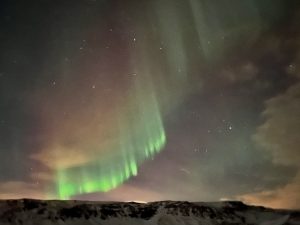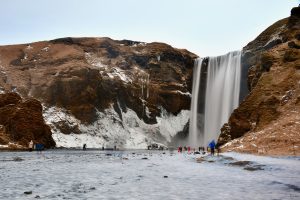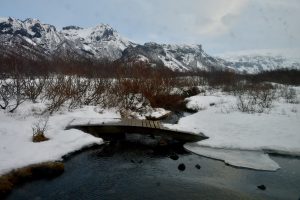The UF/IFAS department of soil, water, and ecosystem sciences offers students the chance to blog about their study abroad experiences. Darci Griffin is majoring in Interdisciplinary Studies: Environmental Management in Agriculture and Natural Resources through UF Online from her home in Palm Beach County, Florida. From January 2nd through the 9th, 2024, she participated in The Green Program: Renewable Energy Innovation and Sustainability. Reykjavik University’s School of Energy hosted and operated the program. Here is Darci’s study abroad experience:
The opportunity
I don’t always read the College of Agricultural and Life Sciences’ weekly announcements but one day a particular item stood out; information about a trip to Iceland through The Green Program. I immediately started to research it. The 8-day study abroad trip would be short enough that I could go. The biggest draw for me was the chance to see Iceland, but the instruction topics also looked amazing. Iceland gets 100% of its electricity and household heating from renewable resources. I would like to be a naturalist or do something with conservation after I graduate, and I feel that knowing at least a little about renewable resource options is important. My local wetlands are wastewater treatment facilities, and it amazes me what can be done with them.

The beginning
I arrived 3 days before the program started to adjust after a 20-hour travel day and to see a few things in Reykjavik on my own first. I hunted for the northern lights, watched a couple of humpback whales, saw a great Super Mario Bros mural, and experienced the stunning New Year’s Eve fireworks that Reykjavik’s residents ignite. When it was time to meet up with the group from The Green Program, I took a bus back to the airport. There were two guides and 19 students in total. Most of the students were 20-23 years old and one was around my age (43). There may only be 5 hours of sun in Iceland during the winter, but that did not limit what we were able to accomplish during an 8-day study abroad trip with The Green Program.
Renewable Resources
We had 4 lectures in a classroom at Reykjavik University between the first two days. One lecture discussed the history of Iceland, from the glaciers, volcanoes, and tectonic plates that make Iceland what it is, to the early settlers and which countries vied for control during the Second World War. One lecture looked at an overview of energy and environmental policies- who they involve, how they are shaped, and the struggles that Iceland faces with its current policy structure.
The other two lectures detailed geothermal power and hydroelectric power. From the conditions needed for harnessing power from the land to the necessary structures, equipment, and processes, we covered it all. We explored the inner workings of both a geothermal plant and a hydropower plant in person. The tour guides we had imparted even more detailed knowledge of the systems and processes into our brains as we got to see the true scale of the renewable resources we were studying, all while smelling the sulfur in the air or watching a powerful water stream exiting a turbine.
It was obvious everywhere that Icelanders are extremely proud of their successful use of renewable energy sources and efforts to keep Iceland green. The water in Iceland is incredibly clean and everyone drinks water straight from their faucets! Icelandic people source as much food locally as they can. On day 5, lunch was at a greenhouse that grows tomatoes all year round! The greenhouses do need a little extra help from artificial lighting during the dark winters though.
The Capstone
We had some time most days of our trip to work in groups to create a capstone project. The goal: use the information from our lectures and tours to produce a unique, inventive idea about how to use renewable resources to solve a real-world problem. On the last full day of the trip, we presented our capstone projects. We had 15 minutes for overviews of what we would do, why we would do it, and how it would work. We had to consider startup and long-term costs, funding, and who would need to be involved or have a say in the process. The ideas each group shared were incredible.
Our group decided to act as a consulting firm. The idea was to harness waves as a renewable energy source in Newport Beach, California. We would accomplish that by reaching out to Wave Swell Energy in Australia. They already have technology that converts wave energy to electrical energy. We would develop a break-wall design that would harness the wave energy while also helping to reduce coastal erosion. Then we would pitch the technology to the primary power company in Newport Beach. Our plan also added a conservation and restoration idea. It would use some of the proceeds to replant native succulents known as Dudleyas along the cliffs. Their deep roots help stabilize the cliff sides.
Adventure

Are you aware of just how important it is to connect with nature? Those living in Iceland sure are. Most of the students in my study abroad group were surprised at how much they connected with nature during our trip and how much it meant to them by the end of the week.
We worked out in the most exhilarating ways possible! The first full day we hiked up a mountain and had a chance to bathe in a natural hot spring. Unfortunately, I was not in my best shape going into the trip and it took me forever to get up to the end of our trail. However, one of the two guides stuck by my side and encouraged me every step of the way. We started our trek with just a little light left in the sky. However, my view from that mountaintop was clear skies with more twinkling stars than I had ever seen before at one time. While working our way back down the mountain, we had the extreme pleasure of seeing the aurora borealis dancing in the sky!

The next four days we spent our free time visiting waterfalls, watching Geysir erupt, and riding a Super Jeep into Thorsmork Valley where our guides grilled hot dogs. We also had a bonus field trip to the Soil Conservation Service’s visitor center – the first time The Green Program has visited. My absolute favorite outing though, was the day we did a glacier walk! I saw a few glaciers 2 years ago when we took an Alaskan cruise, but not up close and personal. I was not prepared for how mesmerizing and breathtaking it would be to walk between two huge pieces of ice or stand on top of the slab and look around at a gorgeous mountain view. We stood in a silent circle to just be in the moment so we could process where we were and how it made us feel.
Saying goodbye
The last night we all gathered around a fire and shared our personal reflections about the week. It surprised me how many of the students said they were hesitant to take the trip. Many had not traveled before or they were uncertain if they would fit in. Each of them said they were thrilled they made the trip, and they were leaving with great new friends. The Green Program trip was everything I thought it might be and more. I expanded my knowledge of some topics I had already learned about. I learned a ton about renewable resources and enjoyed the educational field trips. It was also a well-deserved break from my everyday stress to connect with nature in an entirely new way. I would take a trip like this again in a heartbeat.
 2
2


